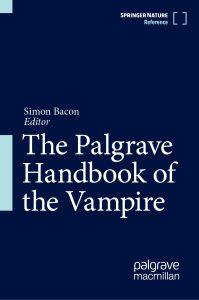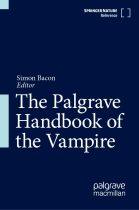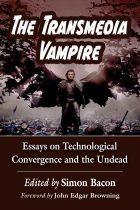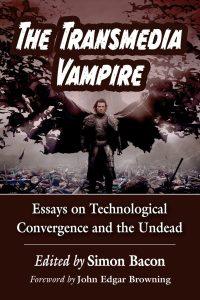2023
 This article discusses the vampiric representation of the jiangshi in Hong Kong and Chinese cinema. The paper argues that while the jiangshi is a monstrous creature in its own right, over the years it has undergone a number of changes to align it with Western vampires. The article begins with a brief discussion of the jiangshi as a literary trope introduced in Chinese stories of the strange, particularly those written during the Qing period. The paper then examines three major shifts in cinematic representation of the creature from its early appearances in the 1980s Hong Kong cinema where it is compared and contrasted with Western vampires, and its post-Handover evolution that follows two different trajectories – reinventing the jiangshi as a pan-Asian horror icon and utilizing it as a tool of the Chinese government anti-superstition propaganda.
This article discusses the vampiric representation of the jiangshi in Hong Kong and Chinese cinema. The paper argues that while the jiangshi is a monstrous creature in its own right, over the years it has undergone a number of changes to align it with Western vampires. The article begins with a brief discussion of the jiangshi as a literary trope introduced in Chinese stories of the strange, particularly those written during the Qing period. The paper then examines three major shifts in cinematic representation of the creature from its early appearances in the 1980s Hong Kong cinema where it is compared and contrasted with Western vampires, and its post-Handover evolution that follows two different trajectories – reinventing the jiangshi as a pan-Asian horror icon and utilizing it as a tool of the Chinese government anti-superstition propaganda.





 This article revisits two of the most iconic Thai monstrosities, phi pop and phi krasue, whose changing representation owes equally as much to local folklore, as to their ongoing reinterpretations in popular culture texts, particularly in film and television. The paper discusses two such considerations, Paul Spurrier’s P (2005) and Yuthlert Sippapak’s Krasue Valentine (2006), films that reject the long-standing notion that animistic creatures belong in the countryside and portray phi pop and phi krasue’s adaptation to city life. Though commonplace, animistic beliefs and practices have been deemed incompatible with the dominant discourses of modernization and urbanization that characterise twenty-first century Thailand. Creatures like phi pop and phi krasue have been branded as uncivilised superstition and ridiculed through their unflattering portrayals in oddball comedies. This article argues that by inviting these monsters to relocate to contemporary Bangkok, Spurrier and Sippapak redefine their attributes for the modern urban setting and create hybrids by blending local beliefs and cinematic conventions. The creatures’ predatory character is additionally augmented by the portrayal of the city as itself vampiric. The article therefore reads these predatory spirits in parallel with the metaphor of the female vampire – a sexually aggressive voracious creature that threatens male patriarchal order and redefines motherhood.
This article revisits two of the most iconic Thai monstrosities, phi pop and phi krasue, whose changing representation owes equally as much to local folklore, as to their ongoing reinterpretations in popular culture texts, particularly in film and television. The paper discusses two such considerations, Paul Spurrier’s P (2005) and Yuthlert Sippapak’s Krasue Valentine (2006), films that reject the long-standing notion that animistic creatures belong in the countryside and portray phi pop and phi krasue’s adaptation to city life. Though commonplace, animistic beliefs and practices have been deemed incompatible with the dominant discourses of modernization and urbanization that characterise twenty-first century Thailand. Creatures like phi pop and phi krasue have been branded as uncivilised superstition and ridiculed through their unflattering portrayals in oddball comedies. This article argues that by inviting these monsters to relocate to contemporary Bangkok, Spurrier and Sippapak redefine their attributes for the modern urban setting and create hybrids by blending local beliefs and cinematic conventions. The creatures’ predatory character is additionally augmented by the portrayal of the city as itself vampiric. The article therefore reads these predatory spirits in parallel with the metaphor of the female vampire – a sexually aggressive voracious creature that threatens male patriarchal order and redefines motherhood.
 This article discusses the construction of K-vampires in popular Korean television dramas, focusing on three series that feature central vampire characters: Vampire Prosecutor, a crime procedural running for two seasons in 2011 and 2012, its spin-off, Vampire Detective (2016) and a medical drama Blood (2015). The main protagonists in these series are all simultaneously vampires and members of professions designed to help humans: a lawyer, a detective and a surgeon. Constructed as parallel to humans, these vampires are portrayed as free-willed individuals striving to overcome their condition. The article argues that the humanisation of K-vampires can be seen as a hybridisation strategy blending the characterisation of the ‘reluctant’ vampires known from Western post-millennial fiction with some features of the Korean kumiho, a supernatural shape-shifting fox creature that desires to become human. The article also proposes to read the series in the Neo-Confucian context, particularly in relation to its social and gender norms. It argues that while the male vampires in the series function chiefly to deliver critique of Korean neoliberal society, with the heroes modelled on the virtuous seonbi scholars and the villains described as sociopathic capitalists, the female vampires are mostly portrayed as tragic heroines, vilified for their moral transgressions and redeemed through selfless sacrifice.
This article discusses the construction of K-vampires in popular Korean television dramas, focusing on three series that feature central vampire characters: Vampire Prosecutor, a crime procedural running for two seasons in 2011 and 2012, its spin-off, Vampire Detective (2016) and a medical drama Blood (2015). The main protagonists in these series are all simultaneously vampires and members of professions designed to help humans: a lawyer, a detective and a surgeon. Constructed as parallel to humans, these vampires are portrayed as free-willed individuals striving to overcome their condition. The article argues that the humanisation of K-vampires can be seen as a hybridisation strategy blending the characterisation of the ‘reluctant’ vampires known from Western post-millennial fiction with some features of the Korean kumiho, a supernatural shape-shifting fox creature that desires to become human. The article also proposes to read the series in the Neo-Confucian context, particularly in relation to its social and gender norms. It argues that while the male vampires in the series function chiefly to deliver critique of Korean neoliberal society, with the heroes modelled on the virtuous seonbi scholars and the villains described as sociopathic capitalists, the female vampires are mostly portrayed as tragic heroines, vilified for their moral transgressions and redeemed through selfless sacrifice.